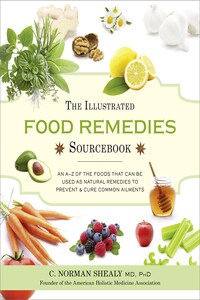HarperCollinsPublishers 77–85 Fulham Palace Road, Hammersmith, London W6 8JB
www.harpercollins.co.uk
First published by HarperCollinsPublishers 2014
FIRST EDITION
© Norman Shealy 2014
Cover layout design © HarperCollinsPublishers Ltd 2014 Cover image © Shutterstock.com
Photographs © Shutterstock. Image 1, Image 2, Image 3, Image 7, Image 11, Image 18, Image 29, Image 46, Image 67, Image 156, Image 161, Image 239, Image 249, Image 250, Image 262, Image 272, Image 277 © iStockphoto.
Norman Shealy asserts the moral right to be identified as the author of this work
All rights reserved under International and Pan-American Copyright Conventions. By payment of the required fees, you have been granted the nonexclusive, non-transferable right to access and read the text of this e-book on screen. No part of this text may be reproduced, transmitted, downloaded, decompiled, reverse engineered, or stored in or introduced into any information storage retrieval system, in any form or by any means, whether electronic or mechanical, now known or hereinafter invented, without the express written permission of HarperCollins e-books.
Find out about HarperCollins and the environment at www.harpercollins.co.uk/green
Source ISBN: 9780007938827
Ebook Edition © NOVEMBER 2014 ISBN: 9780007581153 Version: 2014-11-11
“Let food be thy medicine and medicine be thy food.”
Hippocrates, the father of medicine
Food is required for life. From the simplest one-celled organism to the most complex of animals—all require a variety of essential nutrients to stay alive and function healthily.
Over the years, a number of diets, both fad and scientifically led, have existed to promote a healthy lifestyle, reduce obesity, and improve well-being. Countless diets and nutrition regimes have come and gone, including, among others, the Paleolithic (Paleo) diet, with its focus on wild foods, the low-carbohydrate Atkins diet, and the nutrition-based, low-carb diet promoted by Dr. Broda Barnes. However, the most crucial element to take from any one of these is the focus on nutrients for health and listening to the needs of your own body. The Illustrated Food Remedies Sourcebook provides a reference to promote health and well-being, as well as to cure ailments and illnesses, nourishing from the inside out. Feel free to read the book from cover to cover, or dip in and out, using the index at the back to guide you. Simple tweaks to your everyday diet could add up to huge changes in your future health!
Current U.S. Department of Agriculture Vitamin and Mineral Recommendations
| Micronutrient | Current DV1 | UL2 |
|
Vitamin A
|
5,000 IU
|
3,000 mcg (10,000 IU)
|
|
Vitamin C
|
60 mg
|
2,000 mg
|
|
Calcium
|
1,000 mg
|
2,000 mg
|
|
Iron
|
18 mg
|
45 mg
|
|
Vitamin D
|
400 IU
|
100 mcg (4,000 IU)
|
|
Vitamin E
|
30 IU
|
1000 mg
|
|
Vitamin K
|
80 mcg
|
ND
|
|
Thiamin
|
1.5 mg
|
ND
|
|
Riboflavin
|
1.7 mg
|
ND
|
|
Niacin
|
20 mg
|
35 mg
|
|
Vitamin B6
|
2 mg
|
100 mg
|
|
Folate
|
400 mcg
|
1,000 mcg
|
|
Vitamin B12
|
6 mcg
|
ND
|
|
Biotin
|
300 mcg
|
ND
|
|
Pantothenic acid
|
10 mg
|
ND
|
|
Phosphorus
|
1,000 mg
|
4 g
|
|
Iodine
|
150 mcg
|
1,100 mcg
|
|
Magnesium
|
400 mg
|
350 mg
|
|
Zinc
|
15 mg
|
40 mg
|
|
Selenium
|
70 mcg
|
400 mcg
|
|
Copper
|
2 mg
|
10,000 mcg
|
|
Manganese
|
2 mg
|
11 mg
|
|
Chromium
|
120 mcg
|
ND
|
|
Molybdenum
|
75 mcg
|
2,000 mcg
|
|
Chloride
|
3,400 mg
|
3.6 g
|
1 The table lists the Daily Values (DVs) based on an intake of 2,000 calories, for adults and children four or more years of age. The nutrients in the table above are listed in the order in which they are required to appear on a dietary supplement label. This list includes only those nutrients for which a DV has been established.








